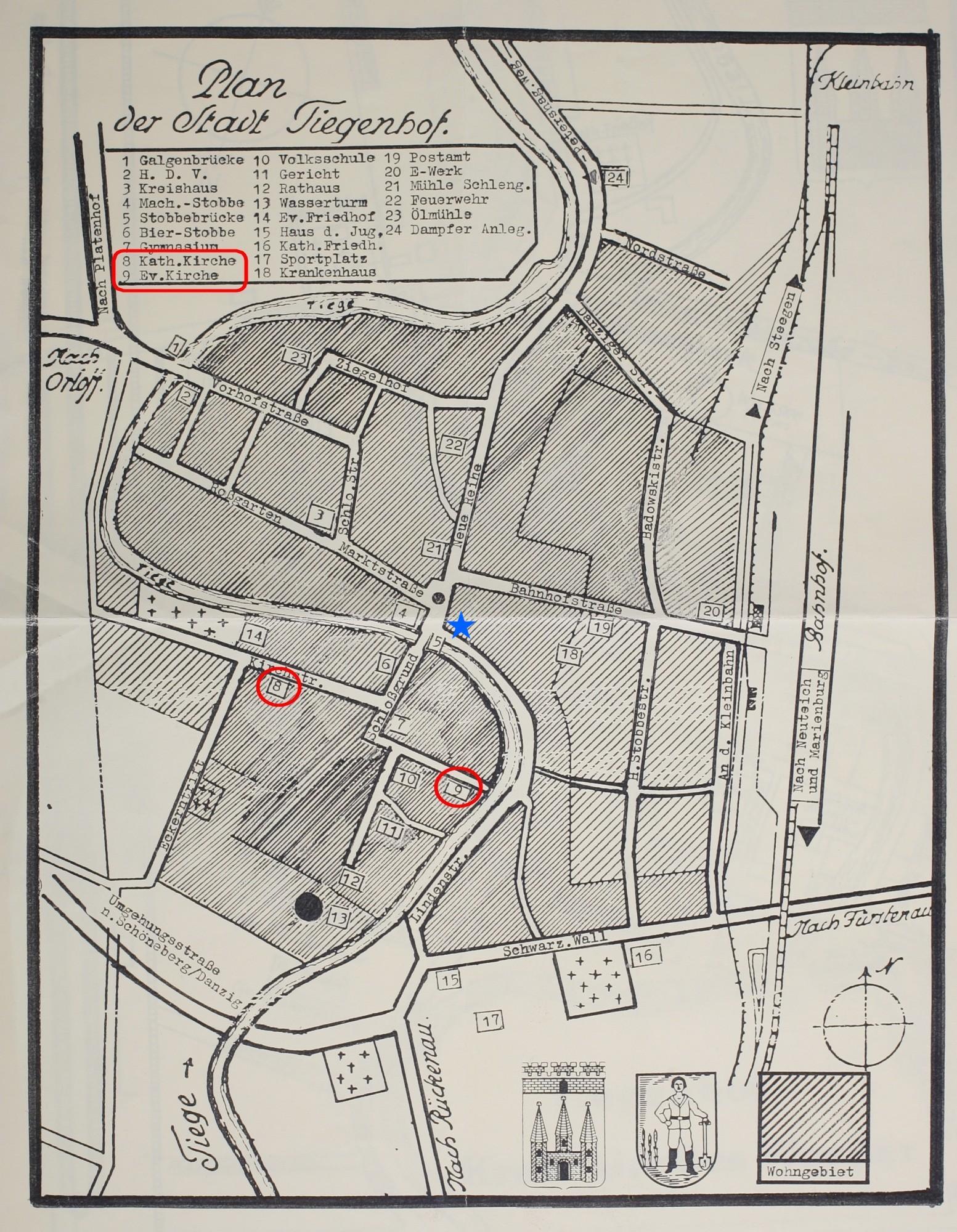Map of Tiegenhof from the German era, showing the location of Paechter's store in blue.
Paechter's store pinpointed on a vintage map of Tiegenhof
Referring again to the Unzer Danzig article, it is possible to follow along on Otto Stobbe's boyhood path as he walks to the steamship landing.
We lived in the Lindenallee, in the Freiwaldschen house, next to the Kinderchen print shop of the "Tiegenhöfer Wochenblatt". When I now visualize the path that we had to take to meet the steamer, memories of people and events come to me that bring my old hometown, which hardly exists today, to life again before my eyes.
You can see Lindenstraße, which he calls Lindenallee, following the S-curve of the Tiege River as it comes into town from the south. The landing is at the north end of town, at location 24 on the map, labeled as Dampfer Anleg., or steamboat landing.
(The red markings on the map show the locations of the Protestant and Catholic churches, and were already on the source map I used. However, the blue marking is mine. More on that in a moment.)
Over there, on the left bank [of the river], in front of my grandparents' garden, Nitsch, the giant with gigantic boots, marked out his ice rink lined with straw every year and always kept it swept. The adults paid one or two "Ditschen" [10-pfennig piece], for which the ice skates were also strapped on. We students only needed to pay five pfennigs, I think...
You can picture the ice rink at the bend in the river with Otto's relatives' home and garden on the left bank.
The owner of the Stobbe brewery, had ice sawed before he had his Ice machine was set up. Columns of workers came and first sawed strips and then these into cubes.... With the help of hooks they were pulled out of the water, pushed off... and piled into an elongated pyramid on a free space between the grandfather's wall and the "high school", as the secondary school was popularly called. The ice lasted until late autumn and even until the next winter and supplied the brewery.
You see Bier Stobbe and Gymnasium on the map at numbers 6 and 7.
But if it was possible, we children ran up the Schwente to the beautiful, wide place where there was brick barn on one side, the Janzen'sche restaurant with the beautiful shady garden, which was already a popular excursion destination for our grandparents. and behind it the brickworks.... On the right-hand side, already on the market square, was the Pächter'sche department store....
The Schwente was another name for the southern reaches of the Tiege. So he is continuing around the bend on the Lindenallee, past the brick barn and the restaurant with the brickworks behind it. Then further along, right at the corner as you come to the market square, on the right side was Paechter's. I marked it with the blue star in the image.
A few years later, in the fall of 1898, the terrible fire began here, which then left half of Bahnhofstrasse in ruins.
You can see how a conflagration at this location could have easily spread to the buildings behind it on Bahnhofstraße.
Unfortunately, my image in the previous post does not seem to match this location. The building in that image is on Marktstraße, so I must conclude it is not our ancestor's department store. However, the yellow-brick half-timber contstruction must be very similar in style to the Paechter store.
Below is another beautiful image looking from the square to the west along Marktstraße. Notice the clock in the center of the square is also shown on the map.

